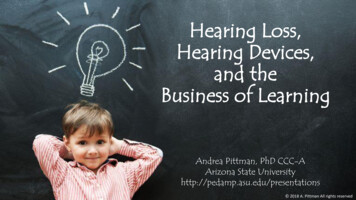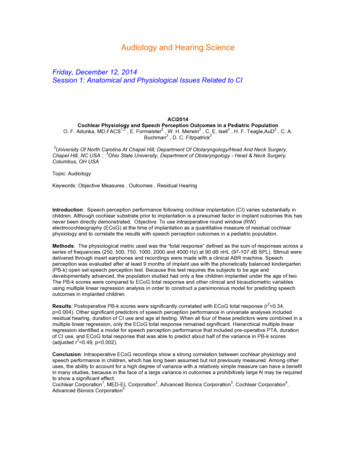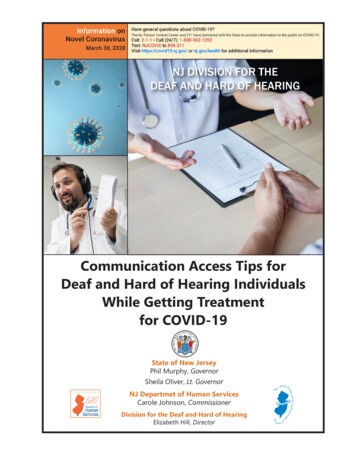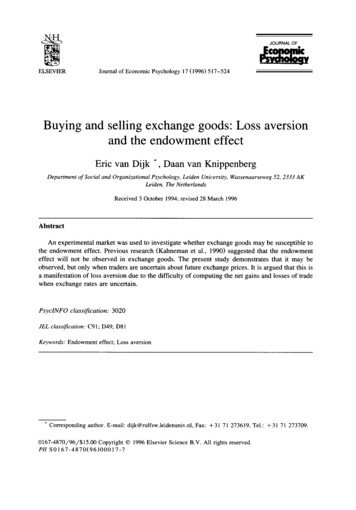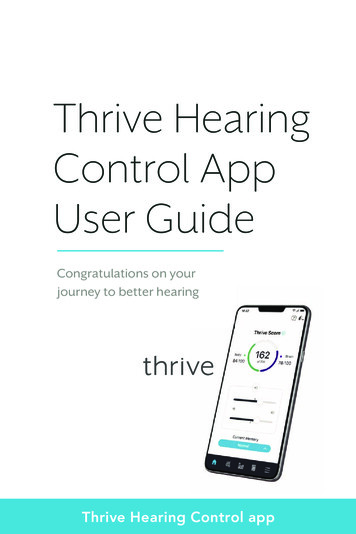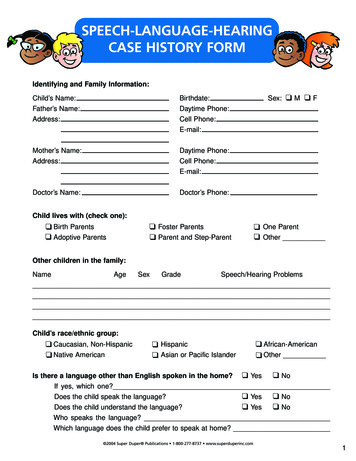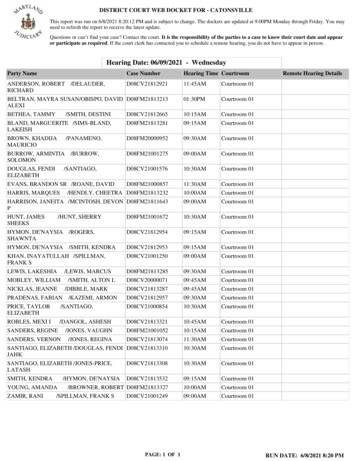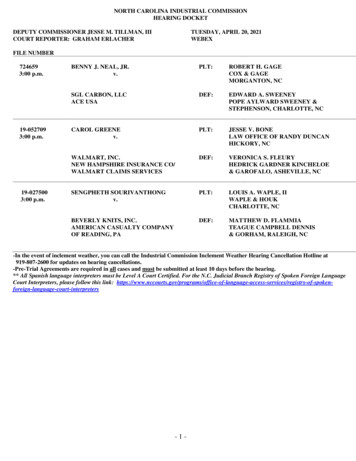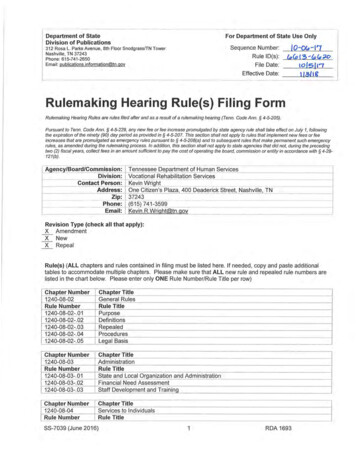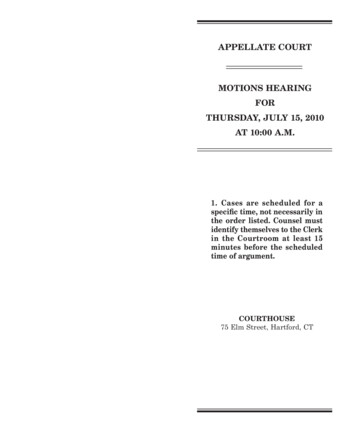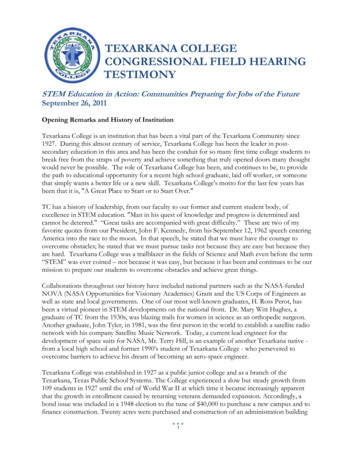Transcription
Hearing Loss, Hearing Devices,and the Business of ChildhoodAndrea Pittman, PhD CCC-AArizona State Universitypedamp.asu.edu/presentationsPediatric Amplification LabWe Give Kids Volume
DisclosuresThis work was supportedby grants from:And the help of research assistants (The Pitt Crew):Current:Elizabeth RainyLauren MeadowsNicole MarzanBeatriz LazaroPrevious:Ian OdgearAmanda WillmanMadalyn RashBrittany SchuettAnd collaborators:Hearing IndustryResearch ConsortiumArizona CommunityFoundationLeadership FundRachel Krupa – Mesa Public Schools, AZJudy Attaway – Casa Colina Hospital, CADan Duran – Valley Children’s Hospital, CAKari Morgenstein – Miami Univ Hospital, FLKristy Winters – Michigan Univ Hospital, MIElizabeth StewartAshley WrightAmy Stahl(and many more)
The kids we’re talking about
The kids we’re talking aboutHEARING LOSS(degree)ProfoundMild0510AGE (years)1518
The business of childhood
Vocabulary DevelopmentSecretly Awesome242018HEARING LOSS (degree)PPVT Vocabulary Age (Yrs)81 HI Children110 NH ChildrenNHCHIC22161412108AGE (years)64246Pittman & Latto (1998-2008)81012Chronological Age (Yrs)1416
Vocabulary DevelopmentSecretly AwesomeHEARING LOSS (degree)40 HA Children47 CI ChildrenAGE (years)Blamey et al (2001) Relationships among speech perception, production, language, hearing loss, and age in children with impaired hearing, JSLRH, 44, 264-285.
Vocabulary Knowledge - College Students1201068082604020PPVT Overestimate (120 items)PPVT Standard Score10030Overestimateof VocabularyKnowledge25201515.51057.793 Hearing loss97 Normal hearingHEARING LOSS (degree)VocabularyKnowledgeAGE (years)00NHHLNHHLSarchet et al (2014), Vocabulary knowledge of deaf and hearing postsecondary students, J Postsecond Educ Disabil, 27(2), 161-178.
What does it take to learn a new word?To learn a new word a child needs to be able to:1)2)3)4)Perceive speechDetect that a word is new (unknown)Learn what the new word meansRemember the new word
Auditory Lexical Decision Task“Swim”RepeatCategorizeSwimRealSwimNot RealSrimRealSrimNot RealWhimRealWhimNot latNot RealGlatRealGladNot RealGladRealGratNot RealGratReal“Glat”
Amplification Bandwidth (Wide vs Narrow)Frequency (kHz)0.250.5121.0480Level (dB HL)204060801000.25UNAIDEDFrequency (kHz)0.512-20AIDED120048Wideband (Porp. Correct)-200.80.60.40.2WidebandNLFCLevel (dB HL)200.0400.0600.20.40.60.8Narrowband (Prop. Correct)1.080100120UNAIDEDAIDED OFFAIDED ONPittman, Stewart, Odgear & Willman (2017) Detecting and learning new words: The impact of advancing age and hearing loss. American Journal of Audiology.
Digital Noise Reduction (On vs Off)0.25Frequency (kHz)0.5121.048-20DNR On (Prop. Correct)0Level (dB HL)20406080100120BINAURAL FF UNAIDEDBINAURAL FF OFFBINAURAL FF ON0.80.60.40.20.00.00.20.40.60.8DNR Off (Prop. Correct)Pittman, Stewart, Willman & Odgear (2017) Word recognition and learning: Effects of hearing loss and amplification feature, Trends in Hearing.1.0
Bone Conduction (Softband vs Direct)1208060400.125In-situ Thresholds (dB HL)-200.250.5120.25Frequency (kHz)0.5124480.40.20.0406080Pittman (in progress)0.60.0201200.880100Direct Coupling (Prop Correct)Force 0.8Softband Coupling (Prop Correct)1.0
Non-Word Detection 2.00112234NEXT# ofnonsensewordsExample phrase0Clocks tick on time.1Birds rike long worms2Dats catch slow bice.3-4-
Amplification (Unaided vs Aided)1.0Frequency (kHz)Hearing Level (dB HL)-20020406080100120Pittman & Daliri (in progress)1248Aided (Prop. Correct)0.25 ed (Prop. Correct)1.0
Bone Conduction (Softband vs Direct)Direct Coupling (Prop. Correct)1.00.80.60.40.2RealNonsense0.00.0Pittman (in progress)0.20.40.60.81.0Softband Coupling (Prop. Correct)
PERFORMANCE (% Correct)Rapid Word Learning1009080706050403020100𝑃𝑐 1 0.80𝑒 𝑛/𝑐5254565 85 105 125 145TRIALSLearning Speed:3 1 trial (perfect learning)2 10 trials1 100 trials0 1000 trials (no learning)
Rapid Word Learning115 correct/150 trials 77%
High-Frequency Amplification3Frequency (kHz)0.5124-200Level (dB HL)204060801000.25UNAIDEDFrequency (kHz)0.512-20AIDED120020Level (dB HL)NLFCWB848Wideband (learning speed)0.2521040060123Narrowband (learning speed)80100120UNAIDEDAIDED OFFAIDED ONPittman, Stewart, Odgear & Willman (2017) Detecting and learning new words: The impact of advancing age and hearing loss. American Journal of Audiology.
Digital Noise Reduction (on vs off)0.25-200Level (dB HL)20406080100120BINAURAL FF UNAIDEDBINAURAL FF OFFBINAURAL FF ON48DNR On (Learning Speed)3Frequency (kHz)0.512210012DNR Off (Learning Speed)3Pittman, Stewart, Willman & Odgear (2017) Word recognition and learning: Effects of hearing loss and amplification feature, Trends in Hearing.
Bone Conduction (direct vs softband)Direct Coupling (learning speed)3.02.52.01.51.00.50.00.0 0.5 1.0 1.5 2.0 2.5 3.0Softband Coupling (learning speed)Pittman (in progress)pedamp1.asu.edu/presentations
Group Results – Amplification Bandwidth.730.60.40.20.8.84.710.60.40.20.00.0WORD RECOGNITION3.00.8.660.6.590.40.20.0LEXICAL DECISIONLEARNING SPEED (LOG N/1000).870.8PERFORMANCE (PROP. CORRECT)PERFORMANCE (PROP. CORRECT)NBWB1.0PERFORMANCE (PROP. CORRECT)1.01.02.52.01.791.51.0.890.50.0NWD 1.0WORD LEARNINGPittman, Stewart, Willman & Odgear (2017) Word recognition and learning: Effects of hearing loss and amplification feature, Trends in Hearing.
Group Results – Digital Noise 60.4.46.460.2LEARNING SPEED (LOG N/1000)0.8PERFORMANCE (PROP. CORRECT)PERFORMANCE (PROP. CORRECT)DNR OFFDNR ON1.0PERFORMANCE (PROP. CORRECT)1.01.02.52.01.51.00.5.460.00.0WORD RECOGNITION0.0LEXICAL DECISION.460.0NWD 1.0WORD LEARNINGPittman, Stewart, Willman & Odgear (2017) Word recognition and learning: Effects of hearing loss and amplification feature, Trends in Hearing.
Group Results – Bone Conduction0.74 0.760.60.40.20.80.710.60.610.40.20.00.0WORD RECOGNITIONPittman (in progress)SENSITIVITY (D-PRIME)0.82.03.01.51.441.01.180.50.0LEXICAL DECISIONLEARNING SPEED (LOG N/1000)1.0SoftbandDirectPERFORMANCE (PROP. CORRECT)PERFORMANCE (PROP. CORRECT)1.02.52.01.51.191.00.840.50.0NWD 2.0WORD LEARNING
Are the new words remembered?Retention PosttestNameNamePittman, Wright, Latto, Wright (in process)LearningName
Are the new words remembered?NORMAL HEARINGPerformance (% Correct)100HEARING n, Wright, Latto, Wright (in process)200If given enough trials,children with hearing loss canlearn as quickly as childrenwith normal hearing but theyneed more training thanchildren with normal hearingto remember what they’velearned.
Catching up
Vocabulary SizeThe average undergraduate student knows between15,000 and 200,000 words (D’Anna et al, 1991).Oxford Dictionary of American English:1000 new entries each year1. new words2. new definitions to existing wordsD’Anna, Zechmeister, and Hall (1991) Toward a meaningful definition of vocabulary size. Journal of Reading Behavior 23.1: 109–22.
Let’s do a little math Children:50,000 word vocabularylearned over 18 years (3 to 22 years) 7 new words everydayAdults:1,000 new words per year 3 new words every day
Vocabulary Knowledge - AdultsOlder adults outperform younger adults on standardized vocabularytests (Verhaeghen, 2003).Flynn Effect: Scores increase with age due to a cohort effect thatfavors the earlier born (Flynn, 1987).-50201960197019801990200020 yrs70 yrs2010VocabTestVerhaeghen (2003) Aging and Vocabulary Scores: A Meta- Analysis. Psychology and Aging, 18(2), 332–339.Flynn (1987) Massive IQ gains in 14 nations: What IQ tests really measure. Psychological Bulletin, 101, 171–191.2020
Vocabulary Knowledge - AdultsWord Type#ExampleOld Words15 Aghast: Filled with horror or shockOld words witha new definition15Ship: The desire of a fan for two fictionalcharacters to be in a romantic relationshipNew words15Geotag: An electronic tag that assigns ageographical location to a photographNonsense words5DesillPittman, Stahl & Marzan (in process)
Vocabulary Knowledge - Adults1.00.9Performance0.80.720-30 yrs n 4840-50 yrs n 5060-70 yrs n 160.60.50.40.30.20.10.0OverallPittman, Stahl & Marzan (in process)Old WordsNew WordsNonsense Words
Vocabulary Knowledge - Adults1.0Performance (Prop. Correct)0.921 Adults 19-88 years0.80.7Old Words: r -.17, p .510.6Partial correlations controlling for age0.50.4New Words: r -.83, p .001*0.3Partial correlations controlling for age0.2Old WordsNew Words0.10.00Pittman, Stahl & Marzan (in process)1020 30 40 50 60 70 80 90 100Degree of Hearing Loss (4FPTA, dB HL)
What have we learned today?
We’ve learned that Perceiving words we already know is easy,but learning new words is more challenging.Learning new words is directly related to:1) the quality of the auditory signal2) the opportunities to learningWhen we optimize amplification for children(and adults), we optimize their opportunities to learn.pedamp1.asu.edu/presentations
Thank you!pedamp.asu.edu/presentations
Judy Attaway –Casa Colina Hospital, CA Dan Duran –Valley hildren’s Hospital, A . American Journal of Audiology.-20 0 20 40 60 80 100 120 0.25 0.5 1 2 4 8) Frequency (kHz) UNAIDE
